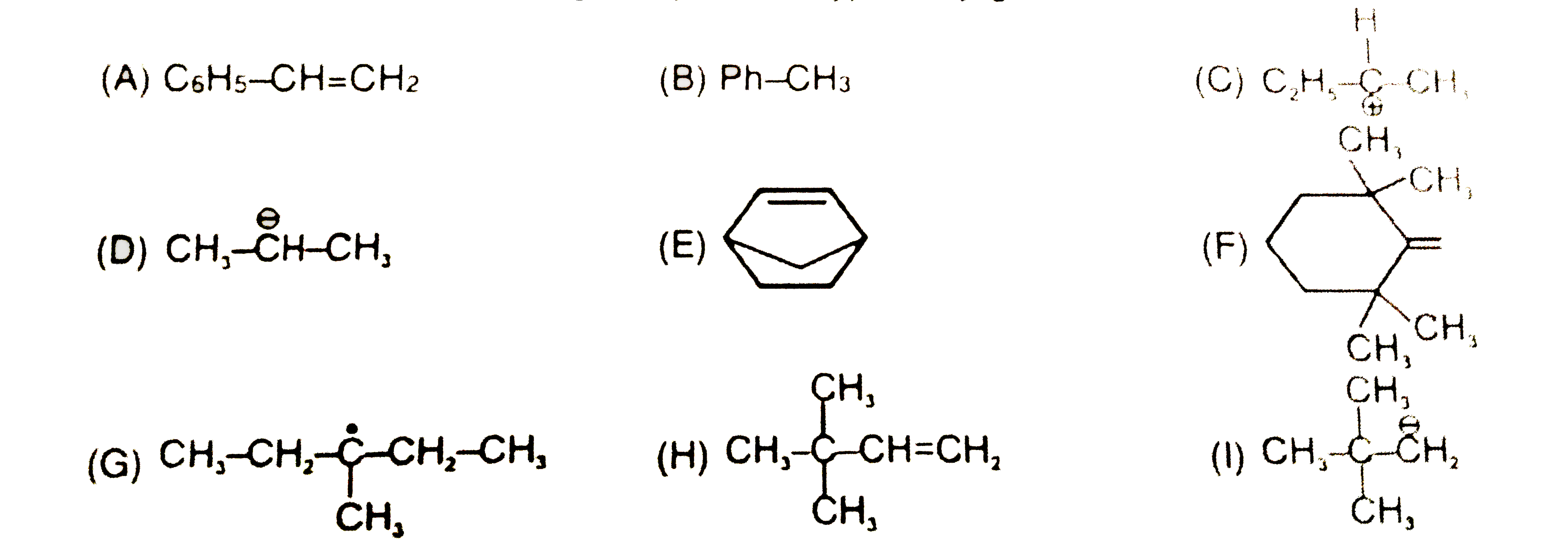Hyperconjugation observed in

.CPh3


The correct Answer is:D
To determine which molecules exhibit hyperconjugation, we need to understand the concept of hyperconjugation and identify the presence of alpha hydrogen atoms in the given options. Here is a step-by-step solution:
Step 1: Understand Hyperconjugation
Hyperconjugation is the interaction between the electrons in a sigma bond (usually C-H or C-C) and an adjacent empty or partially filled p-orbital or pi-orbital. This interaction leads to the stabilization of the molecule.
Hint: Remember that hyperconjugation involves sigma bonds and adjacent empty or partially filled orbitals.
Step 2: Identify Alpha Hydrogen Atoms
For hyperconjugation to occur, the molecule must have alpha hydrogen atoms. Alpha hydrogens are those hydrogen atoms that are attached to the carbon atom adjacent to a double bond, positive charge, free radical, or negative charge.
Hint: Look for hydrogen atoms attached to carbons next to double bonds or charged species.
Step 3: Analyze Each Option
Now, we will analyze each option to see if it contains alpha hydrogen atoms.
1. Option 1: The molecule has no alpha hydrogens because all hydrogens are replaced by methyl groups. Thus, it cannot exhibit hyperconjugation.
Hint: Check for the presence of hydrogen atoms on the carbon adjacent to the reactive site.
2. Option 2: This molecule has a free radical. The adjacent carbon has one hydrogen atom, which is an alpha hydrogen. Therefore, this molecule can exhibit hyperconjugation.
Hint: Identify the free radical and check the adjacent carbon for hydrogen atoms.
3. Option 3: Similar to option 2, this molecule has a free radical with one hydrogen atom on the adjacent carbon. Hence, it can exhibit hyperconjugation.
Hint: Look for the free radical and count the hydrogen atoms on adjacent carbons.
4. Option 4: This molecule has no alpha hydrogens as all valencies of the carbon are satisfied with other groups. Thus, it cannot exhibit hyperconjugation.
Hint: Ensure that the carbon adjacent to the reactive site has available hydrogen atoms.
Conclusion
Based on the analysis:
- Option 2 and Option 3 show hyperconjugation due to the presence of alpha hydrogen atoms.
- Option 1 and Option 4 do not show hyperconjugation as they lack alpha hydrogen atoms.
Final Answer: Hyperconjugation is observed in Option 2 and Option 3.
Hyperconjugation is the interaction between the electrons in a sigma bond (usually C-H or C-C) and an adjacent empty or partially filled p-orbital or pi-orbital. This interaction leads to the stabilization of the molecule.
For hyperconjugation to occur, the molecule must have alpha hydrogen atoms. Alpha hydrogens are those hydrogen atoms that are attached to the carbon atom adjacent to a double bond, positive charge, free radical, or negative charge.
Now, we will analyze each option to see if it contains alpha hydrogen atoms.
Hint: Check for the presence of hydrogen atoms on the carbon adjacent to the reactive site.
Hint: Identify the free radical and check the adjacent carbon for hydrogen atoms.
Hint: Look for the free radical and count the hydrogen atoms on adjacent carbons.
Hint: Ensure that the carbon adjacent to the reactive site has available hydrogen atoms.
Based on the analysis:
- Option 2 and Option 3 show hyperconjugation due to the presence of alpha hydrogen atoms.
- Option 1 and Option 4 do not show hyperconjugation as they lack alpha hydrogen atoms.
Topper's Solved these Questions
- GENERAL ORGANIC CHEMISTRY-IBOOK - RESONANCE ENGLISHCHAPTER - GENERAL ORGANIC CHEMISTRY-IEXERCISE - PART-2(NSEC)
24 Videos
- GENERAL ORGANIC CHEMISTRY-IBOOK - RESONANCE ENGLISHCHAPTER - GENERAL ORGANIC CHEMISTRY-IEXERCISE - PART-III : PRACTICE TEST-2
1 Videos
- GENERAL ORGANIC CHEMISTRY-IBOOK - RESONANCE ENGLISHCHAPTER - GENERAL ORGANIC CHEMISTRY-IEXERCISE - JEE(MAIN) ONLINE PROBLEMS
2 Videos
- GENERAL ORGANIC CHEMISTRY IIBOOK - RESONANCE ENGLISHCHAPTER - GENERAL ORGANIC CHEMISTRY IIEXERCISE - Part-III: Section-5: Matching List Type
1 Videos
- HYDROGEN AND ITS COMPOUNDSBOOK - RESONANCE ENGLISHCHAPTER - HYDROGEN AND ITS COMPOUNDSEXERCISE - INORGANIC CHEMISTRY(Hydrogen & its compunds Y environment chemistry)
33 Videos
Similar Questions
Knowledge Check
Hyperconjugation is
Aσ−π conjugationBnoticed due to delocalisation of σandπ bondCno bond resonanceDall the aboveHyperconjugation occurs in :
A B
B C
C DNone of these
DNone of these
Hyperconjugation is absent in which species?
View SolutionHyperconjugation is defined as No bond resonance. The concept of hyperconjugation arose from the discovery of electron releasing pattern for alkyl groups. It involves σ electrons of C-H bond. Greater the number of C-H bond (α-hydrogen atom w.r.t. double bond) more will be hyperconjugative structures, more will be stability Heat of hydrogenation of alkene are affected by hyperconjugative effects.
Which of the following is incorrect hyperconjugative structure?
View SolutionHyperconjugation is defined as No bond resonance. The concept of hyperconjugation arose from the discovery of electron releasing pattern for alkyl groups. It involves σ electrons of C-H bond. Greater the number of C-H bond (α-hydrogen atom w.r.t. double bond) more will be hyperconjugative structures, more will be stability Heat of hydrogenation of alkene are affected by hyperconjugative effects.
Which of the following has highest heat of hydrogenation?
View SolutionIn how many of the following compounds Hyperconjugation effect is observed -

View SolutionHyperconjugation involves delocalization of
View SolutionExplain the
Hyperconjugation effect is also termed as 'no bond resonance'.
View Solution


